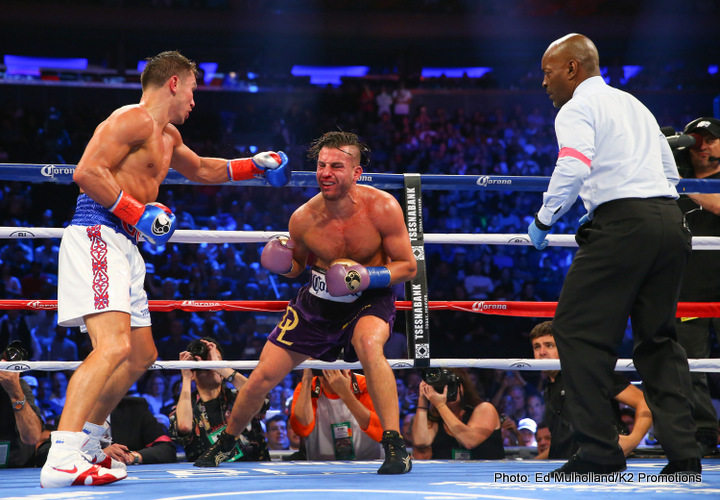When fight fans hear or read the name Gennady Golovkin, immediately the first word that comes up in mind, whether consciously or subconsciously, is “monster” or another suitable synonym no doubt. Hailed as the most dominant prizefighter in today’s Middleweight division, there is an atmosphere to his matches and a very rare type of dominance in his performance which convince people that yes, though GGG hasn’t fought the right kind of competition to call him great, most fans know he is great.
I’m sure fight fans who enjoy the technical works of precision, timing and patience found in the careers of Floyd Mayweather Jr., Guillermo Rigondeaux, and Pernell Whitaker can appreciate GGG’s performance against David Lemieux. Am I saying that GGG is a technical boxer? Obviously not anywhere near the same degree as the three aforementioned boxing grandmasters, but nonetheless GGG understood he couldn’t go about his conventional overwhelming forward pursuit against Lemieux, who himself has been considered a devastating puncher himself with ferocious in-fighting.
Many fans leading up to the fight expected a war, but what they saw was a boxing clinic. Throughout the entirety of the boxing match from Rounds 1-8 Gennady Golovkin stayed incredibly disciplined with his jab, utilizing his reach to keep Lemieux at bay, and thus set-up perfectly timed left hooks to the waist and alternating hooks to the head, most consistently the right. Every time Lemieux would come forward, attempting to administer swift hooks to the head and straight rights to the stomach, GGG simply administered two defensive measures respectively:
1) Step back.
2) Use the philly shell defense.
These were the two main maneuveurs Golovkin used to neutralize Lemieux’s offense, and when considering how Golovkin no doubt has a ferocious instinct which has been repeatedly unleashed throughout his professional career, there is a curiosity about Golovkin’s versatility to be explored here. As a boxer-puncher, Golovkin was able to alternate between being a master of distance with calm, simple and minimalist evasive/defensive maneuver, while in the midst of such frustrating rhythm (in Lemieux’s perspective), GGG would suddenly break up tempo and his poker face and release the “monster” within which we all have come to be familiarized with.
And whenever the “monster” was unleashed, Lemieux was forced against the ropes to stick purely to defense, suffering from a barrage of combinations alternating between body and head as GGG attacked at will.
Most frequently in Round 4, Gennady Golovkin used his reflexes to dodge multiple punches by Lemieux with simple, unexaggerated head movement, slipping his punches again with a very calm self-conservatism.
After knocking down Lemieux in the fifth round, one might have though Gennady Golovkin would have shifted his versatile rhythm towards a completely forward assault, as many of us are used to seeing. And yes, after the two touched gloves after Lemieux got back up, Golovkin indeed unleashed a multitude of relentless punches to end off the round with even further damage without mercy. But in Round 7, Golovkin still stuck to his versatile, fluctuating rhythm. Though applying more pressure with Lemieux clearly hurt from the knockdown, GGG was very mindful of accumulating damage, like Manny Pacquiao, as opposed to rushing in for the knockout, like a young George Foreman or Mike Tyson. And so Gennady Golovkin’s multidimensional perceptions in the midst of brutal combat revealed his sense of not only the timing of punches, but the greater picture of the fight as a whole, as if he were viewing it from an objective perspective outside of his confidence, never forgetting to let passion take over calculation.
GGG hardly made any mistakes in this performance, and once the fight with Canelo Alvarez finally happens, I’m sure that what we will see is a fascinating boxer-puncher match between the two elite warriors, one even more versatile in nature than what we saw between Canelo Alvarez and Miguel Cotto. Another scenario could be this: with Canelo Alvarez coming up in weight and seeming hesitant to fully fledge himself as a Middleweight Champion, Gennady Golovkin may not be as conservative and measuring as he was with Lemieux. After all, I imagine Golovkin’s camp was very conscious of the fact that Lemieux isn’t a multidimensional fighter, who happened to have a much shorter reach and a very predictable come forward style. Such a fighter would have been easily kept at bay by a fighter with GGG’s simultaneously consistent and thudding jab, as was the case. But against a fighter of elite caliber with a versatile boxer-punching style, it would be fascinating to see what Gennady Golovkin would do.
Against Kell Brook, Gennady Golovkin seemed to have taken advantage of his weight advantage, and went about his usual Mexican brawling style against a quick fighter who no doubt holds the greater array of technical abilities, willing to take Brook’s punches as Golovkin would charge in (I must say, Brook was just simply incredible in that match! Brook showed us a great boxer who will show further greatness to come!) Against Alvarez, perhaps it’s hard to predict what Golovkin’s approach to the fight would be, but I’m sure that Golovkin will reveal certain unexpected subtleties of his rarely showcased boxer-punching that’ll make for a very fascinating match up when that day comes.
